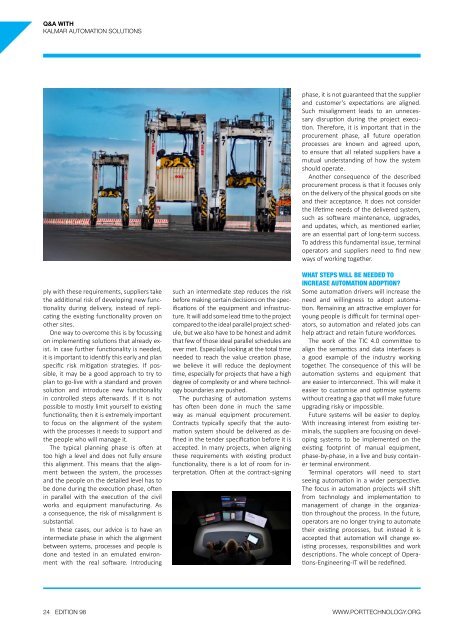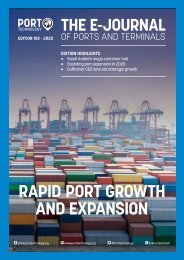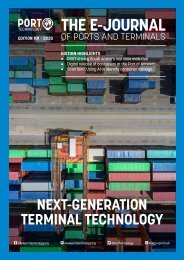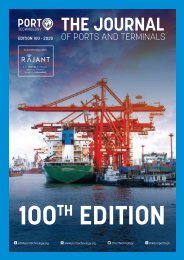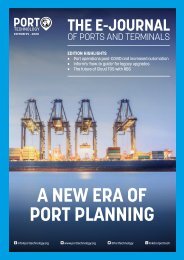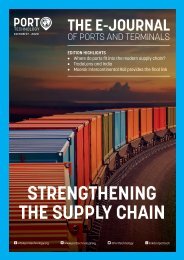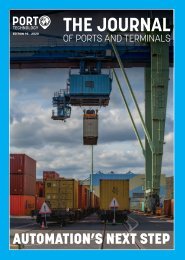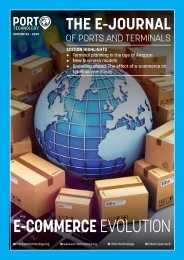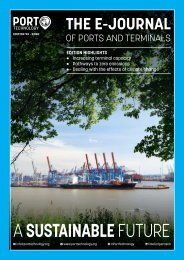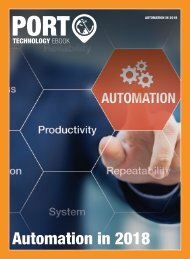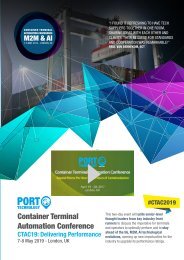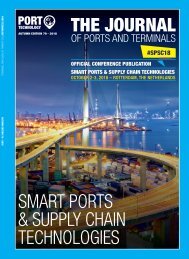Automation Innovations
As we enter the second half of 2020 the full effects of the COVID-19 pandemic are now being realised across the global economy and the port industry. For many, cargo throughput has been significantly decreasing compared with the same period for 2019. For example, the Port of Los Angeles handled 581,665 TEUs in May, a 29.8
As we enter the second half of 2020 the full effects of the COVID-19 pandemic are now being realised across the global economy and the port industry. For many, cargo throughput has been significantly decreasing compared with the same period for 2019.
For example, the Port of Los Angeles handled 581,665 TEUs in May, a 29.8
You also want an ePaper? Increase the reach of your titles
YUMPU automatically turns print PDFs into web optimized ePapers that Google loves.
Q&A WITH<br />
KALMAR AUTOMATION SOLUTIONS<br />
ply with these requirements, suppliers take<br />
the additional risk of developing new functionality<br />
during delivery, instead of replicating<br />
the existing functionality proven on<br />
other sites.<br />
One way to overcome this is by focussing<br />
on implementing solutions that already exist.<br />
In case further functionality is needed,<br />
it is important to identify this early and plan<br />
specific risk mitigation strategies. If possible,<br />
it may be a good approach to try to<br />
plan to go-live with a standard and proven<br />
solution and introduce new functionality<br />
in controlled steps afterwards. If it is not<br />
possible to mostly limit yourself to existing<br />
functionality, then it is extremely important<br />
to focus on the alignment of the system<br />
with the processes it needs to support and<br />
the people who will manage it.<br />
The typical planning phase is often at<br />
too high a level and does not fully ensure<br />
this alignment. This means that the alignment<br />
between the system, the processes<br />
and the people on the detailed level has to<br />
be done during the execution phase, often<br />
in parallel with the execution of the civil<br />
works and equipment manufacturing. As<br />
a consequence, the risk of misalignment is<br />
substantial.<br />
In these cases, our advice is to have an<br />
intermediate phase in which the alignment<br />
between systems, processes and people is<br />
done and tested in an emulated environment<br />
with the real software. Introducing<br />
such an intermediate step reduces the risk<br />
before making certain decisions on the specifications<br />
of the equipment and infrastructure.<br />
It will add some lead time to the project<br />
compared to the ideal parallel project schedule,<br />
but we also have to be honest and admit<br />
that few of those ideal parallel schedules are<br />
ever met. Especially looking at the total time<br />
needed to reach the value creation phase,<br />
we believe it will reduce the deployment<br />
time, especially for projects that have a high<br />
degree of complexity or and where technology<br />
boundaries are pushed.<br />
The purchasing of automation systems<br />
has often been done in much the same<br />
way as manual equipment procurement.<br />
Contracts typically specify that the automation<br />
system should be delivered as defined<br />
in the tender specification before it is<br />
accepted. In many projects, when aligning<br />
these requirements with existing product<br />
functionality, there is a lot of room for interpretation.<br />
Often at the contract-signing<br />
phase, it is not guaranteed that the supplier<br />
and customer’s expectations are aligned.<br />
Such misalignment leads to an unnecessary<br />
disruption during the project execution.<br />
Therefore, it is important that in the<br />
procurement phase, all future operation<br />
processes are known and agreed upon,<br />
to ensure that all related suppliers have a<br />
mutual understanding of how the system<br />
should operate.<br />
Another consequence of the described<br />
procurement process is that it focuses only<br />
on the delivery of the physical goods on site<br />
and their acceptance. It does not consider<br />
the lifetime needs of the delivered system,<br />
such as software maintenance, upgrades,<br />
and updates, which, as mentioned earlier,<br />
are an essential part of long-term success.<br />
To address this fundamental issue, terminal<br />
operators and suppliers need to find new<br />
ways of working together.<br />
WHAT STEPS WILL BE NEEDED TO<br />
INCREASE AUTOMATION ADOPTION?<br />
Some automation drivers will increase the<br />
need and willingness to adopt automation.<br />
Remaining an attractive employer for<br />
young people is difficult for terminal operators,<br />
so automation and related jobs can<br />
help attract and retain future workforces.<br />
The work of the TIC 4.0 committee to<br />
align the semantics and data interfaces is<br />
a good example of the industry working<br />
together. The consequence of this will be<br />
automation systems and equipment that<br />
are easier to interconnect. This will make it<br />
easier to customise and optimise systems<br />
without creating a gap that will make future<br />
upgrading risky or impossible.<br />
Future systems will be easier to deploy.<br />
With increasing interest from existing terminals,<br />
the suppliers are focusing on developing<br />
systems to be implemented on the<br />
existing footprint of manual equipment,<br />
phase-by-phase, in a live and busy container<br />
terminal environment.<br />
Terminal operators will need to start<br />
seeing automation in a wider perspective.<br />
The focus in automation projects will shift<br />
from technology and implementation to<br />
management of change in the organization<br />
throughout the process. In the future,<br />
operators are no longer trying to automate<br />
their existing processes, but instead it is<br />
accepted that automation will change existing<br />
processes, responsibilities and work<br />
descriptions. The whole concept of Operations-Engineering-IT<br />
will be redefined.<br />
24 EDITION 98<br />
WWW.PORTTECHNOLOGY.ORG


